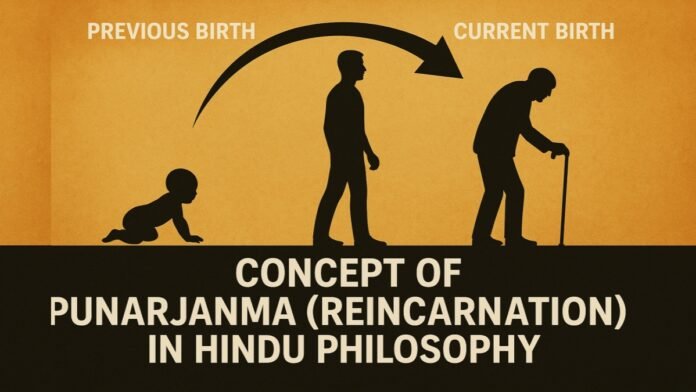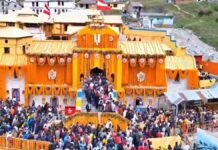
Punarjanma, or reincarnation, is a central concept in Hindu philosophy, deeply rooted in the ancient scriptures such as the Vedas, Upanishads, Bhagavad Gita, and the Puranas. The term punarjanma (Sanskrit: पुनर्जन्मन्) literally means “rebirth” or “repeated birth”. Hinduism teaches that the atman (soul) is eternal and indestructible, while the physical body is temporary. Upon death, the soul leaves its current body and, based on the accumulated karma (actions and their consequences), takes birth in a new body-human, animal, plant, or even divine or demonic forms.
The Bhagavad Gita famously compares this process to changing clothes:
“Just as a man discards worn out clothes and puts on new ones, the soul discards worn out bodies and wears new ones.” (Bhagavad Gita 2.22)
The Upanishads and Rigveda also allude to the soul’s journey through various existences, emphasizing that liberation (moksha)-freedom from the cycle of birth and death (samsara)-is the ultimate goal. This liberation is achieved by overcoming ignorance, desires, and attachment, thereby breaking the cycle of karma and rebirth[.
Mechanism of Rebirth
- The soul (jiva) carries impressions (samskaras) and karma from one life to the next.
- The circumstances of each birth are determined by the moral quality of one’s actions in previous lives.
- The cycle continues until the soul attains spiritual realization and is liberated from maya (illusion) and material bondage.
Scriptural References
- Rigveda: Mentions the migration of the soul and its rebirth in different forms.
- Upanishads: Discuss the soul’s immortality and the process of rebirth, as well as the cessation of rebirth upon realization of Brahman (the ultimate reality).
- Bhagavad Gita: Elaborates on the soul’s eternal nature and the process of reincarnation.
- Garuda Purana: Describes the journey of the soul after death and the judgment of karma before rebirth.
Examples of Reincarnation in Modern Times
While reincarnation is a metaphysical concept, there have been several modern cases that are often cited as suggestive evidence:
1. Shanti Devi (India, 1930s)
- As a child, Shanti Devi from Delhi claimed to remember a past life as Lugdi Devi of Mathura, providing detailed information about Lugdi’s family, home, and circumstances of death.
- An independent commission, including prominent figures and even Mahatma Gandhi’s interest, investigated and verified many of her statements.
- Shanti Devi’s case is considered one of the most compelling and well-documented examples of reincarnation.
2. James Leininger (USA, 2000s)
- James, a boy from Louisiana, began recalling memories of being a World War II fighter pilot named James Huston Jr., including specific details about planes, ship names, and fellow crew members.
- His parents verified these details with historical records and living witnesses, many of which were accurate and unlikely to have been known by a child.
3. Pollock Twins (UK, 1950s)
- After the tragic death of their daughters Joanna and Jacqueline, the Pollock family had twin girls who exhibited behaviors, preferences, and memories similar to their deceased sisters.
- The twins recognized toys and places associated with the previous children, leading researchers to study the case as suggestive of reincarnation.
4. Ryan Hammons (USA)
- As a child, Ryan claimed to be a Hollywood actor named Marty Martyn, recalling specific details about his previous life, which were later verified through research.
5. Sunita Khandelwal (India)
- Sunita recalled a previous life and provided details about her death and family, some of which were verified by independent investigators and medical records.
6. Other Documented Cases
- Researchers like Dr. Ian Stevenson and Dr. Jim Tucker have documented hundreds of cases worldwide, including children in Sri Lanka, Burma, and the West, who recall verifiable details of past lives.
Summary Table: Core Concepts and Modern Examples
| Aspect | Hindu Scriptural View | Modern Example(s) |
|---|---|---|
| Nature of Soul (Atman) | Eternal, indestructible, migrates through bodies | N/A |
| Cycle of Rebirth (Samsara) | Driven by karma, ends with moksha (liberation) | N/A |
| Karma | Actions determine next birth’s circumstances | N/A |
| Scriptural References | Vedas, Upanishads, Bhagavad Gita, Puranas | N/A |
| Famous Modern Cases | N/A | Shanti Devi, James Leininger, Pollock Twins, Ryan Hammons, Sunita Khandelwal |
The concept of punarjanma is foundational in Hindu philosophy, emphasizing the soul’s journey through countless births shaped by karma, with the ultimate aim of achieving liberation (moksha). While direct empirical proof remains elusive, numerous modern cases-such as those of Shanti Devi and James Leininger-have provided intriguing, well-documented instances that continue to fuel interest and research into the phenomenon of reincarnation.







































